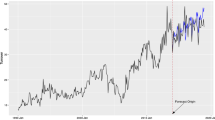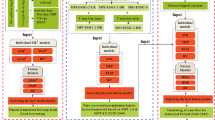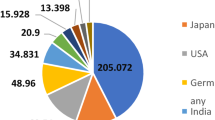Abstract
To address the drawback of single machine learning prediction model which cannot capture the complex hidden factors of crude oil price, ensemble learning method has been widely verified as an excellent solution for crude oil price forecasting. In ensemble learning, diversity strategy is one of the most important determinants to obtain good performance. So, this study introduced the promisingly efficient and fast RVFL network as base models to the framework of ensemble learning and explored diversity strategies in the proposed RVFL network ensemble forecasting model to obtain good performance. Specifically, the impacts of five different strategies including data quantity diversity, sampling interval diversity, parameter diversity, ensemble number diversity and ensemble method diversity on the performance of RVFL network ensemble learning have been examined and analyzed. Experimental results found that the accuracy of ensemble learning models would be increased if diversity strategies were carefully selected. Moreover, the proposed multistage nonlinear RVFL network ensemble forecasting model was consistently better than that of single RVFL network model in terms of the same measurements.




Similar content being viewed by others
References
Alam KMR, Siddique N, Adeli H (2019) A dynamic ensemble learning algorithm for neural networks. Neural Comput Appl 32:8675–8690
Ardila D, Sanadgol D, Sornette D (2018) Out-of-sample forecasting of housing bubble tipping points. Quant Finance Economics 2(4):904–930
Asencio-Cortés G, Florido E, Troncoso A, Martínez-Álvarez F (2016) A novel methodology to predict urban traffic congestion with ensemble learning. Soft Comput 20:4205–4216
Breiman L (1996) Bagging predictors. Mach Learn 26:123–140
Ding J, Wang H, Li C, Chai T, Wang J (2017) An online learning neural network ensembles with random weights for regression of sequential data stream. Soft Comput 21(20):5919–5937
Fan L, Pan S, Li Z, Li H (2016) An ICA-based support vector regression scheme for forecasting crude oil prices. Technol Forecast Soc Change 112:245–253
Folino G, Pisani FS, Pontieri L (2020) A GP-based ensemble classification framework for time-changing streams of intrusion detection data. Soft Comput. https://doi.org/10.1007/s00500-020-05200-3
Freund Y, Schapire RE (1996) Experiments with a new boosting algorithm. Mach Learn Proc Thirteenth Int Conf 96:148–156
Huang GB, Zhu QY, Siew CK (2006) Extreme learning machine: theory and applications. Neurocomputing 70(1–3):489–501
Kaur S, Kumar P, Kumaraguru P (2020) Automating fake news detection system using multi-level voting model. Soft Comput 24:9049–9069
Khwaja AS, Anpalagan A, Naeem M, Venkatesh B (2020) Joint bagged-boosted artificial neural networks: using ensemble machine learning to improve short-term electricity load forecasting. Electr Power Syst Res 179:106080. https://doi.org/10.1016/j.epsr.2019.106080
Koutanaei FN, Sajedi H, Khanbabaei M (2015) A hybrid data mining model of feature selection algorithms and ensemble learning classifiers for credit scoring. J Retail Consum Serv 27:11–23
Krogh A, Vedelsby J (1995) Neural network ensembles, cross validation, and active learning. In: Tesauro G, Touretzky D, Leen T (eds) Advances in neural information processing systems, vol 7. MIT Press, Cambridge, pp 231–238
Kushwaha V, Pindoriya NM (2019) A SARIMA-RVFL hybrid model assisted by wavelet decomposition for very short-term solar PV power generation forecast. Renew Energ 140:124–139
Li J, Wang J (2020) Stochastic recurrent wavelet neural network with EEMD method on energy price prediction. Soft Comput. https://doi.org/10.1007/s00500-020-05007-2
Mejdoub H, Ghorbel A (2018) Conditional dependence between oil price and stock prices of renewable energy: a vine copula approach. Econ Polit Stud 6(2):176–193
Opitz DW, Shavlik JW (1996) Actively searching for an effective neural network ensemble. Connect Sci 8(3–4):337–353
Pao YH, Park GH, Sobajic DJ (1994) Learning and generalization characteristics of the random vector functional-link net. Neurocomputing 6(2):163–180
Paraskevopoulos T, Posch PN (2018) A hybrid forecasting algorithm based on SVR and wavelet decomposition. Quant Finance Econ 2(3):525–553
Qiu X, Suganthan PN, Amaratunga GAJ (2018) Ensemble incremental learning random vector functional link network for short-term electric load forecasting. Knowl Based Syst 145:182–196
Ramírez P, Carta JA (2005) Influence of the data sampling interval in the estimation of the parameters of the Weibull wind speed probability density distribution: a case study. Energ Convers Manag 46(15):2419–2438
Ren Y, Suganthan PN, Srikanth N, Amaratunga G (2016) Random vector functional link network for short-term electricity load demand forecasting. Inf Sci 367–368:1078–1093
Rosen BE (1996) Ensemble learning using decorrelated neural networks. Connect Sci 8:373–384
Schapire RE (1990) The strength of weak learnability. Mach Learn 5:197–227
Sollich P, Krogh A (1996) Learning with ensembles: how overfitting can be useful. In: Advances in neural information processing systems (NIPS), pp 190–196
Song J, Wang X (2019) Customer concentration and management earnings forecast. Econ Polit Stud 7(4):454–479
Sridharan K, Komarasamy G (2020) Sentiment classification using harmony random forest and harmony gradient boosting machine. Soft Comput 24:7451–7458
Sun Y, Hong Y, Wang S (2019) Out-of-sample forecasts of China’s economic growth and inflation using rolling weighted least squares. J Manag Sci Eng 4(1):1–11
Sun S, Fu J, Li A, Zhang P (2020) A new compound wind speed forecasting structure combining multi-kernel LSSVM with two-stage decomposition technique. Soft Comput. https://doi.org/10.1007/s00500-020-05233-8
Tang L, Wu Y, Yu L (2018a) A randomized-algorithm-based decomposition-ensemble learning methodology for energy price forecasting. Energy 157:526–538
Tang L, Wu Y, Yu L (2018b) A non-iterative decomposition-ensemble learning paradigm using RVFL network for crude oil price forecasting. Appl Soft Comput 70:1097–1108
Wang Y, Wang L, Chang Q, Yang C (2020) Effects of direct input–output connections on multilayer perceptron neural networks for time series prediction. Soft Comput 24:4729–4738
Wei Y, Sun S, Ma J, Wang S, Lai K (2019) A decomposition clustering ensemble learning approach for forecasting foreign exchange rates. J Manag Sci Eng 4(1):45–54
Wolpert D (1992) Stacked generalization. Neural Netw 5:241–259
Xie G, Wang S, Zhao Y, Lai KK (2013) Hybrid approaches based on LSSVR model for container throughput forecasting: a comparative study. Appl Soft Comput 13(5):2232–2241
Yu L, Lai KK, Wang S, Huang W (2006) A bias-variance complexity trade-off framework for complex system modeling. Lect Notes Comput Sci 3980:518–527
Yu L, Lai KK, Wang S (2008) Multistage RBF neural network ensemble learning for exchange rates forecasting. Neurocomputing 71(16):3295–3302
Yu L, Wang S, Lai KK (2008) Credit risk assessment with a multistage neural network ensemble learning approach. Expert Syst Appl 34(2):1434–1444
Yu L, Yue W, Wang S, Lai KK (2010) Support vector machine based multiagent ensemble learning for credit risk evaluation. Expert Syst Appl 37(2):1351–1360
Yu L, Xu H, Tang L (2017) LSSVR ensemble learning with uncertain parameters for crude oil price forecasting. Appl Soft Comput 56:692–701
Zhang L, Suganthan PN (2014) Oblique decision tree ensemble via multisurface proximal support vector machine. IEEE Trans Syst Man Cybern 45(10):2165–2176
Zhang L, Suganthan PN (2016a) A comprehensive evaluation of random vector functional link networks. Inf Sci 367–368:1094–1105
Zhang L, Suganthan PN (2016b) A survey of randomized algorithms for training neural networks. Inf Sci 364:146–155
Zhao Y, Li J, Yu L (2017) A deep learning ensemble approach for crude oil price forecasting. Energ Econ 66:9–16
Zhou Z, Wu J, Tang W (2002) Ensembling neural networks: many could be better than all. Artif Intell 137(1–2):239–263
Acknowledgements
This study was funded by National Natural Science Foundation of China (NSFC Nos. 71433001 and 71622011), the National Program for Support of Top Notch Young Professionals, and Beijing Advanced Innovation Center for Soft Matter Science and Engineering.
Author information
Authors and Affiliations
Corresponding authors
Ethics declarations
Conflict of interest
All authors declare that they have no conflict of interest.
Ethical approval
This article does not contain any studies with human participants or animals performed by any of the authors.
Additional information
Communicated by V. Loia.
Publisher's Note
Springer Nature remains neutral with regard to jurisdictional claims in published maps and institutional affiliations.
Rights and permissions
About this article
Cite this article
Yu, L., Wu, Y., Tang, L. et al. Investigation of diversity strategies in RVFL network ensemble learning for crude oil price forecasting. Soft Comput 25, 3609–3622 (2021). https://doi.org/10.1007/s00500-020-05390-w
Published:
Issue Date:
DOI: https://doi.org/10.1007/s00500-020-05390-w




